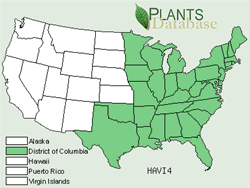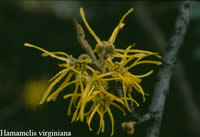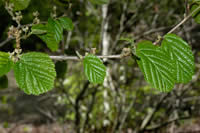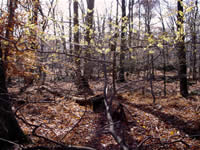Plant of the Week
 Range map of American Witchhazel. States are colored green where American witchhazel may be found.
Range map of American Witchhazel. States are colored green where American witchhazel may be found.
 As the leaves of the trees are all but fallen, the witch hazel comes into glorious bloom in late October to early November in the eastern United States. The yellow flowers exude a pleasant spicy fragrance. Photo by Larry Stritch.
As the leaves of the trees are all but fallen, the witch hazel comes into glorious bloom in late October to early November in the eastern United States. The yellow flowers exude a pleasant spicy fragrance. Photo by Larry Stritch.
 Fruits of the witch hazel from last autumn's flowers are readily visible among the bright green leaves of spring. Photo by J.S Peterson, USDA NRCS PLANTS Database.
Fruits of the witch hazel from last autumn's flowers are readily visible among the bright green leaves of spring. Photo by J.S Peterson, USDA NRCS PLANTS Database.
 To the unwitting hiker, to come upon the flowering witch hazel in late autumn is an unexpected treat as the rest of the forest's plants prepare for a long winter's nap. Photo by Larry Stritch.
To the unwitting hiker, to come upon the flowering witch hazel in late autumn is an unexpected treat as the rest of the forest's plants prepare for a long winter's nap. Photo by Larry Stritch.
American Witchhazel (Hamamelis virginiana L.)
By Larry Stritch
American witchhazel is a member of the Witch-hazel family. The genus name Hamamelis is Latin from the Greek meaning a kind of medlar or service tree. The species name virginiana refers to being from Virginia. This native grows throughout northeast and southeast North America, from Nova Scotia to Florida and from the Great Lakes to eastern Texas.
American witchhazel is a shrub or small tree with arching branches generally growing as a dense, multi-stemmed clump reaching heights of 20 to 30 feet and widths of 15 to 20 feet, however the shrub form typically does not grow over 12 to 15 feet tall.
Leaves are alternate, simple, broadly ovate, 2.5 to 6 inches long, unequal offset leaf base, with large wavy teeth on the margins and with the upper surface dark green and the lower surface a paler green.
This woody plant is extraordinary in its flowering pattern. The flowers are bright yellow, with 4 very slender creamy to bright yellow petals ½ to ¾ inch long, appearing in mid to late fall. The flowers are fragrant. Generally, its bright yellow flowers are the only sign of color in woods where all the autumn leaves lay upon the forest floor. American witchhazel is pollinated by a moth.
The small, tanish to gray, hard capsules go dormant throughout the winter and then develop over the next growing season and then in autumn forcibly expel two shiny black seeds 10 to 20 feet rarely to 40 feet. The seeds then take an additional year to germinate.
American witchhazel posses some interesting lore and uses. The most interesting use as been the use of forked limbs as dowsing or divining rods. Early European settles observed Native Americans using American witchhazel to find underground sources of water. This activity is probably where the common name witchhazel came from. “Wicke” is the Middle English for “lively’ and “wych” is from the Anglo-Saxon word for “bend.” American witchhazel was probably called a Wicke Hazel by early white settlers because the dowsing end of the forked branch would bend when underground water when detected by the dowser. This practice had a widespread use by American settlers and then exported back to Europe. Dowsing became an established feature of well-digging into the 20th century.
American witchhazel is adaptable to home landscaping situations. It should be planted on the north side of homes and north-facing slopes where semi-shaded habits are more common. It prefers rich moist soils and requires regular watering when being established. If planted in the full sunlight it may suffer, occurring in nature as an understory plant. Many gardeners have been abandoning the planting of American witchhazel and are now selecting a number of the Asiatic hybrids. However, their flowers have no fragrance. American witchhazel can be grown from seeds that have been cold stratified. Seeds should be planted in pots and generally grown in them for up to two to three years before they are mature enough to transplant. Flowering does not start until the plants are at least six years old.

